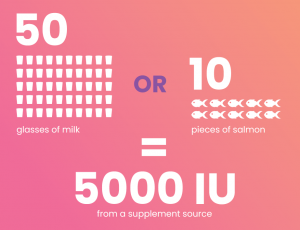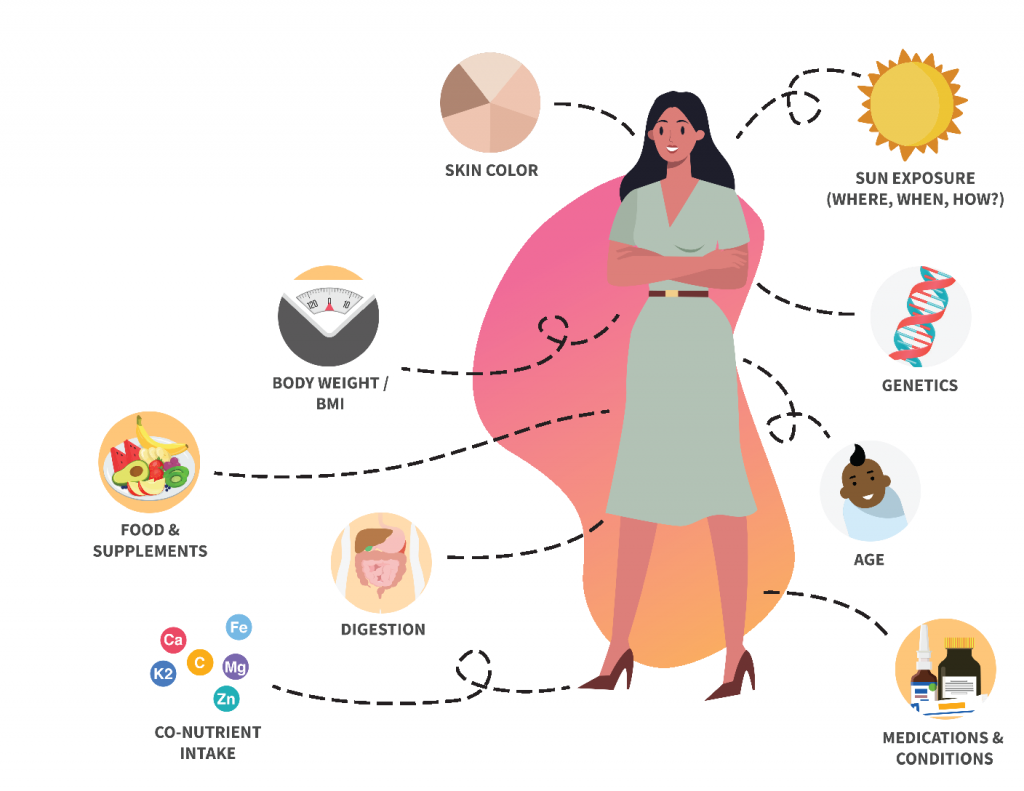Almost 90% of adults and more than 90% of children in the United States are below a vitamin D level of 40-60 ng/ml (100-150 nmol/L)!
This is the agreed upon level based on the consensus of 48 world-renowned, international vitamin D scientists and researchers.
Test your level at home.Check Your Vitamin D Level Now | Find out your risk of being low.Take the Vitamin D Deficiency Risk Assessment Quiz |
What is Vitamin D?
 Vitamin D (the “Sunshine Vitamin”), which is both a nutrient and a hormone, is needed by virtually every cell in the body and is essential for hundreds of processes each and every day. It acts as a regulator of all cell types, tissues, and organs, and enhances the functioning of each system of the body to help keep us healthy.
Vitamin D (the “Sunshine Vitamin”), which is both a nutrient and a hormone, is needed by virtually every cell in the body and is essential for hundreds of processes each and every day. It acts as a regulator of all cell types, tissues, and organs, and enhances the functioning of each system of the body to help keep us healthy.
Why do we need vitamin D?
Every tissue in our bodies needs vitamin D and may be impaired if we do not get enough. In its most extreme forms, vitamin D deficiency results in rickets in children and osteomalacia (bone softening) in adults. Milder degrees of deficiency are being studied as risk factors of a vast array of chronic diseases, including osteoporosis, impaired cognitive and immune function, various autoimmune diseases (such as diabetes and multiple sclerosis), several cancers (such as breast, colon, lung, lymphoma, and prostate), high blood pressure, pregnancy complications, and cardiovascular disease.

Vitamin D deficiency may also be linked to:
Brain
Depression & Anxiety Schizophrenia, Alzheimer’s Disease, ADHD & Autism
Circulatory
High Blood Pressure, Peripheral Artery Disease, Coronary Heart Disease, Atrial Fibrillation
Respiratory
Colds & Flu, Pneumonia & Acute Respiratory Distress Syndrome (ARDS), Asthma, Tuberculosis
Muscle
Neuromuscular Pain, Weakness, Injury
Bone
Rickets, Osteoporosis Fracture
Auto-Immune
Diabetes, Crohn’s Disease, Cancer, Multiple Sclerosis, Psoriasis
Reproductive
Infertility, Preterm Birth & Prenatal Complications
And MORE!
Do you want to limit your risk? Take the quiz now!*
How do you get vitamin D?
 People obtain vitamin D from three sources: sun exposure, food sources, and supplements. However, research shows that even with occasional sun and food sources, most people cannot reach blood levels of 40-60ng/ml (100-150 nmol/L) living a modern lifestyle without supplementation.
People obtain vitamin D from three sources: sun exposure, food sources, and supplements. However, research shows that even with occasional sun and food sources, most people cannot reach blood levels of 40-60ng/ml (100-150 nmol/L) living a modern lifestyle without supplementation.
For example: 50 glasses of milk or 10 pieces of salmon = 5,000IU from a supplement source
Your vitamin D level is more important than how much you take!
Everyone responds differently to vitamin D supplementation… by up to 6 times for the same supplement amount! To help explain this dose-response phenomenon, it is possible for a supplemental intake of 4000 IU/day to result in a serum level of 25 ng/ml (62.5 nmol/L) in one individual, and 60 ng/ml (150 nmol/L) in another. It is important to understand how these factors can influence your vitamin D dose-response when taking steps to achieve your target vitamin D level.
Whether getting your vitamin D from the sun or a supplement, several factors can affect how much vitamin D is made, absorbed, or converted for use in the body, and determine how much vitamin D your cells may actually be getting on a daily basis (see diagram below).
Measure Your Vitamin D Level – Get 10% Off Your First Test with FirstTest10
Could these factors be increasing your risk of low vitamin D?

Do you want to limit your risk? Take the quiz now!*
How can you know if you are getting enough vitamin D?
The only way to know is to measure the vitamin D level. The total 25(OH)D level is the accepted measure used to determine the current/baseline vitamin D status. Measuring vitamin D is the only way to know if an individual is getting enough and how much supplementation may be needed!
Go Straight to Ordering Your Vitamin D Test; Use Code FirstTest10 for 10% Off
People who have current vitamin D deficiency may not have any symptoms or may experience any of the following symptoms:
- Lack of focus
- Dizziness
- Frequent infections
- Exhaustion
- Weakness
- Headaches
- Body pain
- Depression
- Anxiety
What is your risk of a vitamin D level below recommended?
Find out now by taking the free quiz!*
* This quiz and scoring tool are currently in beta mode
References
Dudenkov DV, Yawn BP, Oberhelman SS, Fischer PR, Singh RJ, Cha SS, Maxson JA, Quigg SM, Thacher TD. Changing Incidence of Serum 25-Hydroxyvitamin D Values Above 50 ng/mL: A 10-Year Population-Based Study. Mayo Clin Proc. 2015 May;90(5):577-86. doi: 10.1016/j.mayocp.2015.02.012. PMID: 25939935; PMCID: PMC4437692.
Garland CF, Kim JJ, Mohr SB, Gorham ED, et al. Meta-analysis of All-Cause Mortality According to Serum 25-Hydroxyvitamin D. Am J Public Health, August 2014. 2014;104:e43–e50.
Grant WB, Al Anouti F, Boucher BJ, et al. A Narrative Review of the Evidence for Variations in Serum 25-Hydroxyvitamin D Concentration Thresholds for Optimal Health. Nutrients. 2022;14(3):639. Published 2022 Feb 2. doi:10.3390/nu14030639
Holick MF. Vitamin D Is Not as Toxic as Was Once Thought: A Historical and an Up-to-Date Perspective. Mayo Clin Proc. 2015;90(5):561-564. doi:10.1016/j.mayocp.2015.03.015
Kimball SM, Holick MF. Official recommendations for vitamin D through the life stages in developed countries. Eur J Clin Nutr. 2020;74(11):1514-1518. doi:10.1038/s41430-020-00706-3
Kimball, S.M.; Mirhosseini, N.; Holick, M.F. Evaluation of vitamin D3 intakes up to 15,000 international units/day and serum 25-hydroxyvitamin D concentrations up to 300 nmol/L on calcium metabolism in a community setting. Dermatoendocrinology 2017, 9, e1300213
McCullough, P.J.; Lehrer, D.S.; Amend, J. Daily oral dosing of vitamin D3 using 5000 TO 50,000 international units a day in long-term hospitalized patients: Insights from a seven year experience. J. Steroid Biochem. Mol. Biol. 2019, 189, 228–239
McDonnell SL, Baggerly CA, French CB, Baggerly LL, Garland CF, Gorham ED, et al. Breast cancer risk markedly lower with serum 25-hydroxyvitamin D concentrations ≥60 vs <20 ng/ml (150 vs 50 nmol/L): Pooled analysis of two randomized trials and a prospective cohort. PLoS ONE, 2018, 13(6): e0199265.
McDonnell SL, Baggerly KA, Baggerly CA, Aliano JL, French CB, Baggerly LL, et al. Maternal 25(OH)D concentrations ≥40 ng/mL associated with 60% lower preterm birth risk among general obstetrical patients at an urban medical center. PLoS ONE, 2017, 12(7): e0180483.
Muñoz A, Grant WB. Vitamin D and Cancer: An Historical Overview of the Epidemiology and Mechanisms. Nutrients. 30 March 2022; 14(7):1448.

